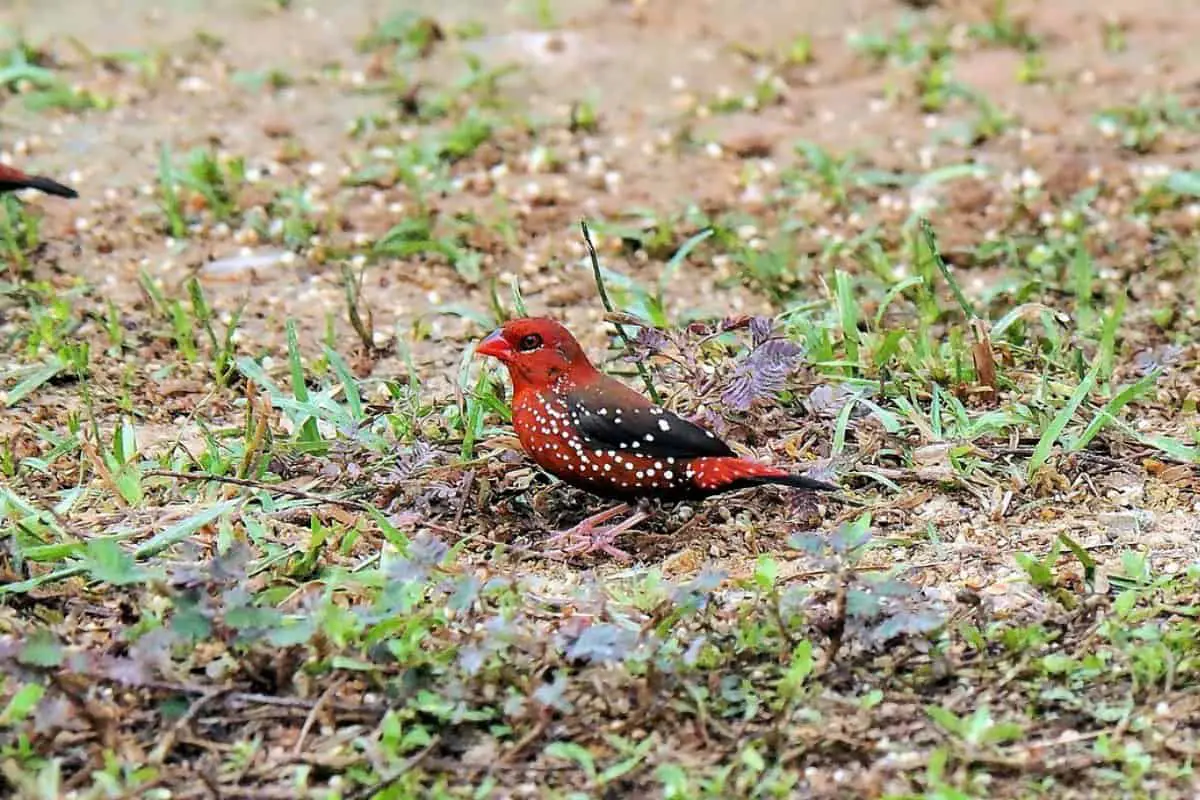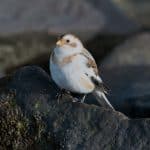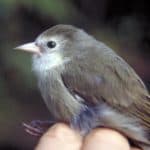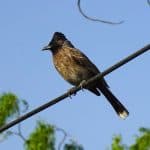Common Name: Red Avadavat
Scientific Name: (Amandava amandava)| Size | Diet | Range in Hawaii | Status in Hawaii |
|---|---|---|---|
| 4.5 in. | seeds, grains, and various insects | O'ahu, Kaua'i, Big Island, and Ni'ihau | Least Concern |
The Red Avadavat, also known as Amandava amandava, is a small songbird species that is native to South Asia. While the species is not native to Hawaii, it has been long established and is considered a naturalized (non-native) resident of the islands. With its vibrant red plumage and cheerful chirping, the Red Avadavat is a fascinating bird species that has captured the attention of birdwatchers and avian enthusiasts around the world.
In this article, we will explore the world of the Red Avadavat, its unique characteristics, and its presence in Hawaii.
Red Avadavat
Appearance
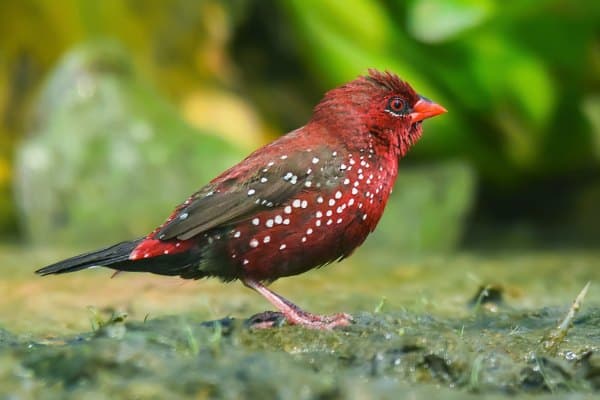
The Red Avadavat is a striking bird that captures attention with its vibrant appearance. This small finch, measuring around 4.5 inches in length, boasts a rich and radiant red plumage that covers its body.
Its bright hues are reminiscent of a succulent strawberry, earning it the affectionate nickname “Strawberry Finch” among bird enthusiasts. The male sports particularly bold colors, with its head, back, and breast drenched in fiery crimson, while the female displays a more subdued yet still alluring palette.
Diet
This small finch menu is diverse, consisting of seeds, grains, and various insects. This avian gourmand is particularly fond of grass seeds, showcasing a preference for the seeds of wild grasses and cultivated plants. Additionally, it dabbles in the realm of insects, capturing small insects and their larvae to supplement its nutritional needs.
Nesting
This diminutive finch showcases remarkable craftsmanship in its nesting habits. Using a combination of grasses, twigs, and fine plant fibers, the avadavat constructs a well-structured cup-shaped nest. These cozy homes are often tucked away in tall grasses or shrubs, offering protection and seclusion for the forthcoming brood.
What makes the Red Avadavat’s nesting behavior particularly interesting is its penchant for communal nesting. Multiple pairs of these finches often build their nests in close proximity, creating a shared neighborhood of interconnected avian abodes.
This social nesting arrangement might offer a sense of safety in numbers or foster a communal bond among the avian residents. As the female tends to the task of incubating the eggs, the male may assist in gathering nesting materials or providing occasional snacks.
Behavior

These finches possess a lively energy, hopping among grasses and shrubs in search of seeds and insects. Their social interactions are equally enchanting. Red Avadavats are known to engage in playful courtship displays, with the male showcasing his brilliant red plumage to court potential mates.
Once paired, these birds often share not only nesting sites but also a sense of community with neighboring pairs, creating an avian neighborhood rich in camaraderie. Their musical talents add another layer to their enchanting behavior. Males contribute to the ambiance with melodious songs, which are often sweet and rhythmic, enhancing the natural soundscape of their surroundings.
Habitat
The Red Avadavat is often found in grasslands, open meadows, and agricultural fields, where its vivid red plumage beautifully contrasts against the verdant surroundings. These finches also possess a penchant for human-altered landscapes. They are frequently spotted in areas with tall grasses, overgrown fields, and even near human settlements.
Range

The Red Avadavat, known as the “Strawberry Finch,” has found a new home in Hawaii. Originally from South Asia, it established itself on O’ahu in the early 1900s, later expanding to Kaua’i, Hawai’i I, and possibly Ni’ihau. Its captivating red plumage now graces these islands, showcasing its successful establishment in the Hawaiian archipelago.
Conservation Status
The Red Avadavat (Amandava amandava) is classified as a species of “Least Concern” by the International Union for Conservation of Nature (IUCN). This classification indicates that the species is not currently facing significant threats that would qualify it for a higher conservation status.
Interesting Facts
1. Symbolism in art and culture
The Red Avadavat’s vibrant colors and charming behavior have made it a subject of interest in art, literature, and cultural symbolism in its native regions.
2. Pet trade
The Red Avadavat is popular in the aviculture trade due to its vibrant appearance and charming behavior. However, capturing and trading wild birds can have negative impacts on wild populations and ecosystems.
3. Introductions to non-native habitats
The Red Avadavat has been introduced to various non-native locations around the world, including Hawaii and Fiji. These introductions have raised concerns about their potential impact on local ecosystems due to their rapid establishment and communal nesting habits.
4. Potential hybridization
In introduced populations, there have been reports of hybridization between the Red Avadavat and other closely related species, raising concerns about genetic introgression and the potential impact on native gene pools.
5. Invasive species concerns
In some introduced locations, such as Hawaii, the Red Avadavat has raised concerns about its potential to become invasive and impact local flora and fauna. Their communal nesting and foraging behaviors could contribute to these concerns.
Frequently Asked Questions
1. How do Red Avadavats communicate?
Red Avadavats communicate through a combination of vocalizations and body language. Males sing melodious songs to attract females and establish their territory.
2. What role do Red Avadavats play in their ecosystems?
In their natural habitats, Red Avadavats play a role in seed dispersal as they consume a variety of seeds and grains. This can contribute to plant regeneration and ecosystem health.
3. Are Red Avadavats territorial?
Male Red Avadavats can be territorial during the breeding season as they establish and defend their nesting sites and areas where they attract females.
4. What is the lifespan of a Red Avadavat in the wild?
In the wild, Red Avadavats typically have a lifespan of a few years. In captivity, with proper care, they may live longer.
5. Are there any ongoing research projected Avadavats?
Researchers may be studying various aspects of Red Avadavat behavior, ecology, and interactions in both their native and introduced habitats.
